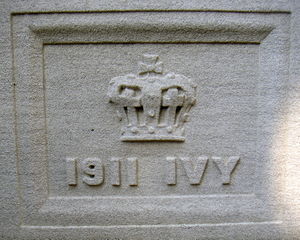Class Ivy
The planting of Class Ivy by graduating seniors is a tradition at many colleges. While no such tradition remains at Columbia, vestiges of the old tradition may be seen around campus.
Class Ivy at Columbia

Columbia had a planting ceremony tradition dating back to at least 1875.[1] At some point it seems that the tradition may have died out, perhaps as a result of the cramped space on the Midtown campus, or broken by the move to the Morningside Heights campus. Whichever the case, notes regarding the class of 1906 state that "an old Columbia custom, the Class Pilgrimage was revived. In place of the yew trees of former years, a class ivy was planted at the northwest corner of St. Paul's Chapel."[2] In June 1907 the class voted to install a tablet to mark the location.[3] It is unclear when the planting tradition was ceased.
Ivy Orations
Ivy Day at Barnard
Barnard adopted a class ivy tradition in 1909, dubbed "Ivy Day", after previous attempts to plant class trees failed. [4] Clearly something is up with the soil in Morningside heights. The tradition appeared to be ending 1913, when the Barnard Ivy orator declared her oration was an obituary for the even which was being discontinued.[5] Nonetheless, it appears the tradition survived through at least 1914.[6]
- ↑ Class Day at Columbia College, New York Times, 15 June 1875.
- ↑ Columbia University Quarterly Review, Volume 8, Pg. 442. It is unclear what precisely was being revived, since Ivy orators were still being selected as early as 1898, see e.g. Columbia University Bulletin, March 1898, Pg. 145. Perhaps 1906 was marked the revival of a planting ceremony in addition to an oration. The reference to yew trees is also interesting since the 1875 mention is of Ivy.
- ↑ Columbia University Quarterly Review, Volume 9, Pg. 413.
- ↑ The American Education Review, Volume 30, Oct 1908 - Sept 1909, pgs. 537-538.
- ↑ Give Up Steps At Barnard, New York Times, 4 June 1913.
- ↑ Columbia University Quarterly Review, Volume 16, Pg. 413.